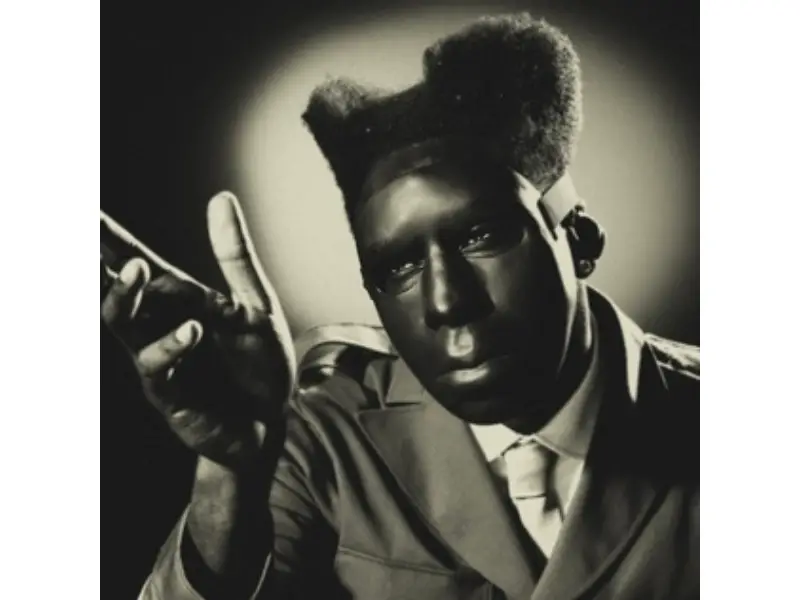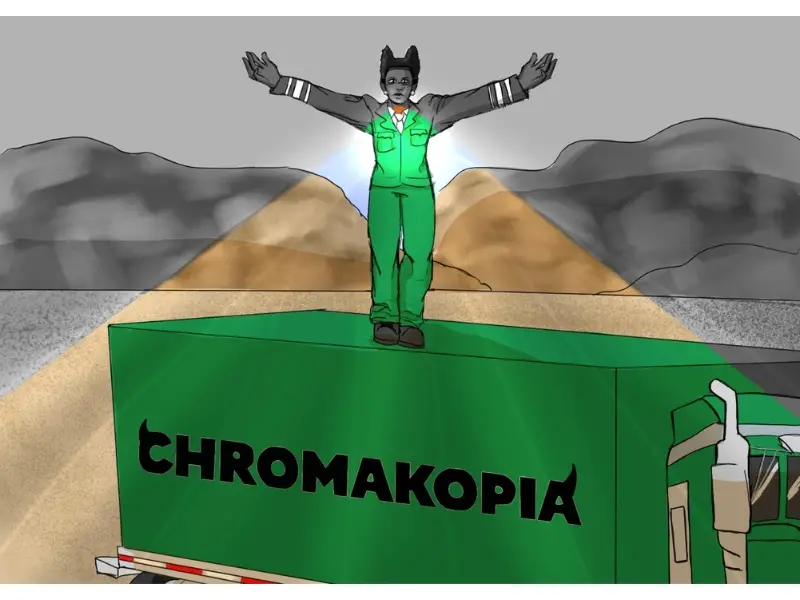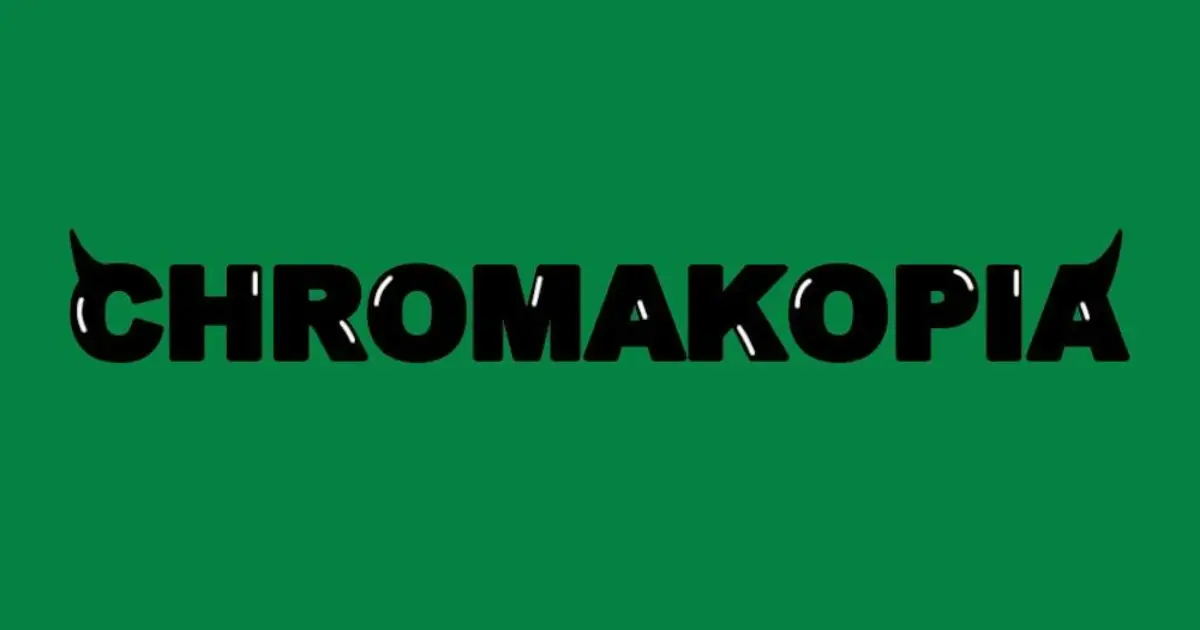Tyler doesn’t waste any time discarding the rulebook. The man who revolutionized shock-rap as high fashion and turned golf wang kids into flower boys has always flown under his own rainbow – and Chromakopia might be his boldest flex yet. The album title is like a technicolor teaser that even his most diehard fans can’t help but wonder:
What world of sound is Tyler taking us to this time?
We’re about to take this thing apart piece by piece, every squeal of modular synth and every gospel-tinged admission until Chromakopia’s DNA is laid bare. The militaristic stomps on “St. Chroma,” the horror-movie guitars on “Noid,” it’s all part of Tyler’s mind puzzle. If you’re a longtime fan who’s been with Tyler since the Odd Future days or just came across his Louis Vuitton-scented renaissance, reading into the album’s meaning on a track-by-track basis will undoubtedly change how you think of what Tyler has been making.
The Meaning Behind the Name Chromakopia
What Chromakopia Actually Means?
It’s the type of wordplay that would make Greek scholars and rap heads want to fist-bump. The first part of this food for thought, chroma, is not just a random word the ancient Greeks threw on a menu. It means color, in the most colorful way possible. Anyone who has followed this man from Goblin to IGOR knows that color is not just something you see, it’s an entire emotional spectrum he has been using since the beginning. The second word, kopia, gives off copious—when there’s too much of something, like bars in a Tyler verse—or maybe even copy, like the funhouse mirrors that allow you to see yourself from each angle. Stack those things together and Chromakopia becomes an explosion of ideas, like when the synths detonate on “RUNNING OUT OF TIME” or when he’s building those stacked, masked-up personas that have the internet theorizing for months. The title isn’t just some random name he pulled out of his Louis Vuitton bag—it’s 100% Tyler. The man who turned Golf Wang into a lifestyle and made flower boys mainstream knows exactly what he’s doing. On Chromakopia, he’s given us a key to his creative compound, and every song feels like a room overlooking his pool of sonic paintings. He’s taken every color in his palette—from Bastard’s darkest blacks to Flower Boy’s brightest yellows—and created something that’s both his greatest hits and a new frequency.
Symbolism in Tyler, The Creator’s Music
Tyler Okonma is a master of symbolism. It’s a tenet of his craft. From Flower Boy’s pastoral daydreams to IGOR’s lovesick transformations, his albums often feel like leather-bound tomes you might find in some cult indie bookstore. He maps identity politics, romantic heartbreak, and most importantly vulnerability, with the surgical precision of a guy with a butterfly knife. Tyler has always done this on a symbolic level, but Chromakopia ups the ante. The album is a sensory deprivation chamber in reverse—it’s Tyler flooding his listeners with a prismatic sound that reflects his growth as an artist. It’s not a progression of the last album; it’s Tyler dismantling his mythos and the ways in which he expresses himself through sound and image becoming almost overwhelming.
Fan Theories About Chromakopia‘s Deeper Meaning
Like moths to a particularly enigmatic flame, Tyler’s fans have already dissected Chromakopia like its a medical cadaver. Over Reddit comment sections and Twitter threads, their take on the album is split between the literal—Chromakopia is a tactile exploration of feelings—and the spiritual, with some construing “the abundance of color” as Tyler finally breaks free of his own personas. The parasocial relationships he rapped about on “NOID” are coming back to bite him. Amateur theorists might say that each color in Tyler’s rainbow is a new creative era—from the sun-kissed self-love of Flower Boy to the bleeding-hearted love confessions of IGOR. In this sense, Chromakopia is Tyler’s color wheel, and every time he turns it, a new color of his growth emerges. He told his mother, “You are the light” —except now, that light is filtered through a prism of his own creation. The proliferation of these theories also makes Chromakopia more of a communal effort than a record. It’s a lucid dream that Tyler and his fans have been having since “Wolf.” It’s a boogie in which each person takes a turn trying to lip-read the other.
What Chromakopia Is Really About

Making You Feel With Sound
Tyler doesn’t waste time getting to the feels on Chromakopia, and he doesn’t waste time getting to the point on “Rah Tah Tah”—a song that could have been an album outtake flex but ends up being a lesson in vulnerability. The song’s DNA is both Tyler’s trademark cockiness and hints of confession, with production that bounces between chest-pounding 808s and ambient synth passages that sound like they’re orbiting the Earth. It’s classic Tyler magic: while you’re bobbing your head to the militaristic drums, he’s performing emotion surgery, and the track’s sudden sonic shift is indicative of the way feelings rarely proceed in a straight line. Tyler is the mad scientist behind the boards, and the album functions like a painter’s color wheel. When he wants you to feel joy or nostalgia, the production shimmers with warm brass and sun-kissed keys—Daniel Caesar’s gospel cadences on “St. Chroma” or the lush horn section on the follow-up, “Lumberjack.” Turn the record over and you’ll find the shadows: modular synths that hum like anxious energy, stripped-down production that forces the confession out of Tyler, and an anonymous couple from Nigeria with a front row seat to his murder of his past personas. Each song adjusts Chromakopia’s color to create a portrait that’s less about individual tracks and more about capturing the full spectrum of an artist’s mind. Tyler has taken the mixing board and turned it into a mood ring and we’re all living in his chromatic universe.
Aesthetics and Album Artwork
Chromakopia is a visual supernova to matches the sonic one, and it’s on the same frequency. This is a flex for Tyler, the Creator as an art director—the cover looks like someone cranked up the color settings on the world. Electric blues radiate like synthesizers, oranges and purples are volcanic and cosmic, and Tyler is just flexing his eyes in chromatic color. Even the rollout visuals are more menacing than they need to be. Each frame of the “Sorry Not Sorry” video and promo photo is an intentional flex of Tyler’s artistic skillset. He’s a master of light and shadow now. The technicolor aesthetic is more than a show of his Adobe skills; it’s a mission statement for Chromakopia. Creativity and emotion seep through the screen like osmosis.
How Chromakopia Fits Into Tyler, The Creator’s Artistic Evolution
A Look Back at Tyler’s Previous Albums
Tyler Okonma’s artistry is a lesson in transformation. The shock-value bars and horror-core theatrics of Goblin are a far cry from the luxury rap confessions of Call Me If You Get Lost. Each is a stopgap in Tyler’s evolution, each where he sheds his skin like a snake, revealing more complexities beneath. Those early works, the kind that sparked enough controversy to get an entire country up in arms, are a necessary step to Tyler’s artistic ascension. Flower Boy was the first time Tyler traded shock value for substance, crafting pastel-colored records where loneliness and sexual identity were allowed to live between the bars. Next up was IGOR, a love letter to heartbreak that demolished genre boundaries and caused Tyler to pitch-shift his vocals into new emotional realms, making him sound more akin to a performance artist than a rapper. By the time Call Me If You Get Lost arrived, Tyler had evolved into rap’s most adventurous curator, spinning lyrics about passports and emotional baggage over beats that were Pharrell meets Westside Gunn in a Wes Anderson film.
Chromakopia Is the Album That Tyler, the Creator Was Born to Make
If Call Me If You Get Lost was Tyler flexing his passport, Chromakopia is the album that Tyler excavates his soul. Here’s an album that strips away the masks—both literal and metaphorical—that have defined his career. Tyler modulates between introspective whispers and supernova-bright flexes, painting with a sonic palette that’s both more refined and more adventurous than anything in his discography. This is not simply another Tyler album that showcases his otherworldly imagination. It’s the work of a man comfortable enough with himself to give the world a glimpse past the mask he’s been wearing. In between the militaristic stomps, the ethereal vocals, Chromakopia sounds like an album of confessions rather than observations. Tyler’s freedom of creativity and emotional honesty are finally in perfect sync. And in doing so, he reminds us why he’s not only a visionary, but one of the most fearless truth-tellers in music today, whether the industry is ready or not.
The Cultural Impact of Chromakopia

Chromakopia is not just an album, it’s Tyler rewiring the wiring of modern music. His fusion of genres is less experimentation and more transmutation, turning lead into gold. He makes jazz and trap beats that sound like they were made in a funk laboratory and it works. It’s a big middle finger to everyone who tried to put Tyler in a box. They should know better. Inside the glass mansion of Chromakopia, Tyler is making more than music. His chromatic worldview is seeping into Instagram feeds, runway shows and other art. How he’s weaponizing that chromaticism along with diary-entry bars is sending art kids and streetwear soothsayers scrambling to get in his orbit. Cherry Bomb did this a few years ago but the effect is stronger this time around. You can hear Chromakopia in the DNA of tracks from bedroom producers to stadium headliners. The critical machinery has been running through it like Sunday dinner. Pitchfork and Rolling Stone are racing to anoint it his masterpiece—and for the first time in his career, they might be right. The production sounds like Tyler grabbed the aux cord at God’s house party; every beat and instrumental is both new and old at the same time. At 33, he’s created his most important work to date and it proves that while the rest of the pack are playing follow the leader, Tyler is building his own worlds. It’s the kind of album that makes you understand why the old guard hoards their vinyl; sometimes the sounds just work better when they’re making history.
Chromakopia Merch: Wear Your Love for Tyler The Creator
In the universe of Tyler Okonma’s Chromakopia, the merch line is its own installation—a physicalization of the album’s emotional onslaught. The drop is as timely as Tyler’s most self-aware album to date, so fans can literally wear their creator’s vision on their sleeve: hoodies that could’ve been pulled off by St. Chroma, shirts that reference the album’s chromatic psychology, and accessories that allude to deep cuts in Chromakopia’s most revealing songs. These aren’t just pieces of merchandise, they’re artifacts from Tyler’s latest life cycle, each one deliberately designed to reflect the album’s themes of identity and truth. The design language speaks in the same bold frequencies as Chromakopia’s modular synths and militant drums—think rich colorways that could have been pulled from Sir Baudelaire’s pastel-heavy wardrobe but with Chromakopia’s more introspective methodology. The clothing feels like the physical manifestation of those otherworldly Daniel Caesar vocals on “St. Chroma”—both otherworldly and grounded. For the Tyler stan who wants to travel the same mental landscape as his favorite artist or anyone who recognizes the pull that well-crafted design has on people, this collection is for you. The garments serve as stamps of an artist at the height of his powers, likely to become grails for fashion enthusiasts who recognize that Tyler’s influence is felt far beyond music. Shop the Chromakopia Merch collection now; as the man himself raps on “Sticky,” this is “that nigga and that bitch” manifestation.
Conclusion: What Does Chromakopia Truly Mean?
Like Tyler’s artistic evolution into a more thoughtful rapper, Chromakopia is a testament to creative rebranding. The title—Tyler deliberately combines “chroma” (color) and “kopia” (abundance)—is a masterful example of this. It’s Tyler upending expectations of what he should and could be, the same way he did with Call Me If You Get Lost. Modular synths that sound like kettle whistles and flutes that mimic ululations and battle cries aren’t just elements of Chromakopia. They’re Tyler pulling you through the rabbit hole into his technicolor brain, where vulnerability and flexes are just different colors on the same wheel. It’s genius, really—approach this album like a museum, a docent in a Saint Laurent dress and a Rorschach mask. Tyler made a victory lap and a therapy session, and every beat drop and ad-lib is another brush stroke in the portrait of an artist pushing past his own bounds. The guy who made the white moms in the suburbs clutch their Birkin bags is now making them wonder what they’re missing by not pushing themselves artistically.
FAQs About Chromakopia by Tyler, The Creator
1. What does Chromakopia mean?
I mean—Chromakopia is a combination of “chroma,” meaning color, and “kopia,” meaning abundance, which Tyler is applying to his art. “When I saw the flute,” he says on “St. Chroma,” “It was magical.”
2. When was Chromakopia released?
The prophet dropped this joint on October 28, 2024 and the culture has never been the same.
3. Why did Tyler, The Creator name his album Chromakopia?
The same reason he rocks those pastel ushankas—Tyler is an artist. He’s painting with sound, making his emotional spectrum something you can feel in your chest cavity.
4. What are some of the major themes of Chromakopia?
Creativity, like the sound of that djembe drum, self-expression that cuts deeper than horror-movie guitars, and personal growth that has Tyler admitting things about himself that would make the younger him uncomfortable.
5. How does Chromakopia compare to Tyler’s previous albums?
As he raps on “Tomorrow,” “That version of T that you knew was a memory.”
This isn’t shock-value Tyler or even the Tyler, the Creator who’s flexing on Call Me If You Get Lost—this is Tyler allowing you to see the light that’s not on him, but in him.

